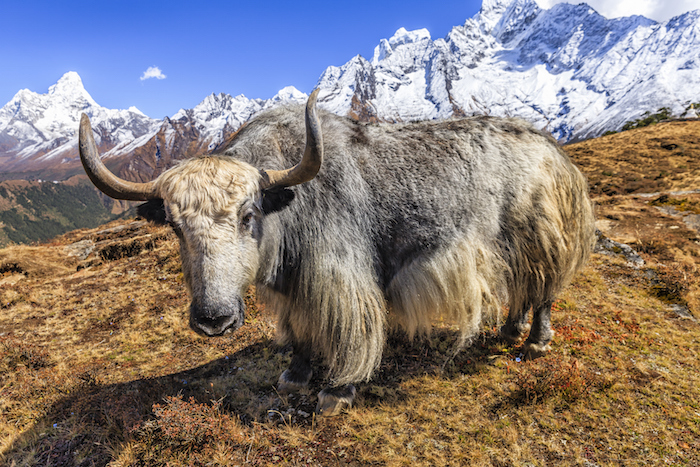A yak is a big animal.
It lives in very cold, high mountains where not many people live.
It has long thick fur to keep it warm.
Yaks eat plants.
Some yaks are wild.
Yaks are in the same family as cows and bison.
What is a yak?
The yak is a long-haired member of the same family as bison, buffalo, antelopes, sheep, goats, oxen and cattle – the bovid family. Most yaks are now domestic animals, but there is a wild population that is classified as Vulnerable. Wild yaks live in remote areas where there are few humans.
Habitat and Distribution (where they are found)
Domestic female yak near a village in Nepal in winter. ©Getty
Almost all yaks are found in the Tibetan plateau of the Himalayas, as far north as Mongolia and Russia. They live around 3,000- 5,000 metres above sea level.
The alpine tundra and cold deserts have temperatures that drop below minus 40ºC, with hail and snow. The vegetation is sparse. Wild yaks stay at lower altitudes during winter months and move to the higher altitudes in warmer months.
Appearance and Behaviours
The yak is the third largest mammal in Asia, after the elephant and rhino. Wild yaks are much larger than domestic yaks: wild adults are 1.5 to 2 metres long and weigh up to1,000 kilograms. Females are smaller.
A yak male in summer on the Tibetan plateau. Photo©Getty
Like most of the bovid family, yaks are herd animals. The size of yak herds ranges from about 10 to 100. Most of a herd consists of females and their young.
The body of a yak is covered with very thick, woolly fur, usually brown, black or white. The fur of domestic yaks is not as thick and in more colours.
Yaks have small ears and a wide forehead, with smooth horns. The horns of males curve outwards and then forwards, ranging from 50 to 100 cm in length, usually a dark colour. Females have smaller, straighter horns, about 27-47 cm long. The horns are used to dig in the snow to find food, and also for defence.
Domestic yaks are used to transport people and loads over distances through the mountains. ©Getty
Yak bodies are so well adapted to the high altitude and cold, harsh habitat in which they live that they are uncomfortable at altitudes below 3,000 metres and suffer from heat exhaustion in temperatures above 15ºC. They have more red cells than other members of their family and no sweat glands.
The hooves of yaks are split, which helps movement over rocky and icy ground.
Yaks have an extra pair of ribs to expand their lung capacity, allowing them to breathe in more oxygen at altitudes where the air is thinner.
Yaks are gentle creatures, though mothers are extremely protective of their calves.
Diet
Yaks are herbivores which means they eat plants. They are ruminants. This means they have four parts to their stomachs so that food ferments in their stomach longer in order to absorb more nutrients from the low quality food they have in their habitat. This digestive system raises the internal temperature of their bodies and helps keep them warm in temperatures as low as minus 40ºC, even when they swim in nearly frozen water.
Yaks feed in the morning and evening, often travelling long distances to find food such as grasses, herbs and lichens.
Read about herbivores and about how ruminants digest their food
Domesticated yaks
This Tibetan farmer has just milked her yak. ©Getty
The domesticated yak is the most important domestic animal in the Tibetan highlands, where survival is tough for humans and animals alike.
Yak bodies provide milk, protein, fur, hoof, bone (made into combs, buttons, ornaments), skin and tail. Their dung is used for fire fuel because wood is scarce.
They are used to transport heavy loads in the mountainous region.
In these remote regions, communities travel great distances to meet up for traditional festivals, where yak racing or yak polo are frequent entertainments.
Life Cycle
Female yak with newborn calf. ©Getty
Wild yaks live for about 20 years. Domestic yaks live slightly longer.
In the wild, yak births are generally between May and June. Nine months after mating with a male, a female gives birth to a single calf. A female gives birth in a quiet spot away from the herd. A calf is able to walk within 10 minutes of being born, and can join the herd with their mother shortly after.
Calves are dependent on their mothers for a year, and females reproduce every second year. Yak calves are fully grown in eight years.
Conservation status and threats
The wild yak is threatened by loss of habitat and hunting by humans. Their natural predators are the Tibetan wolf, brown bears and snow leopards.
It is always a good idea to use more than one source of information so: Read more about yaks
https://onekindplanet.org/animal/yak/






